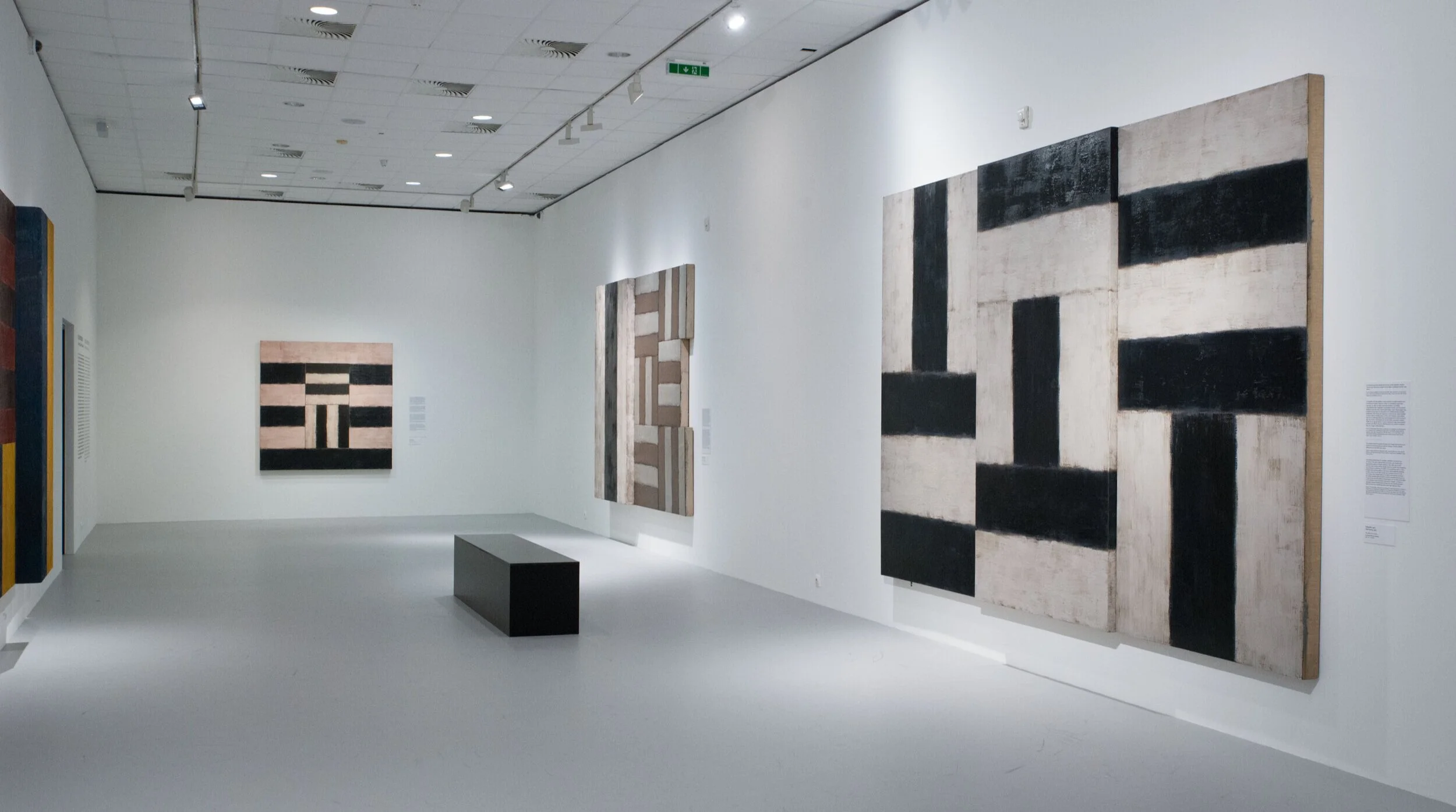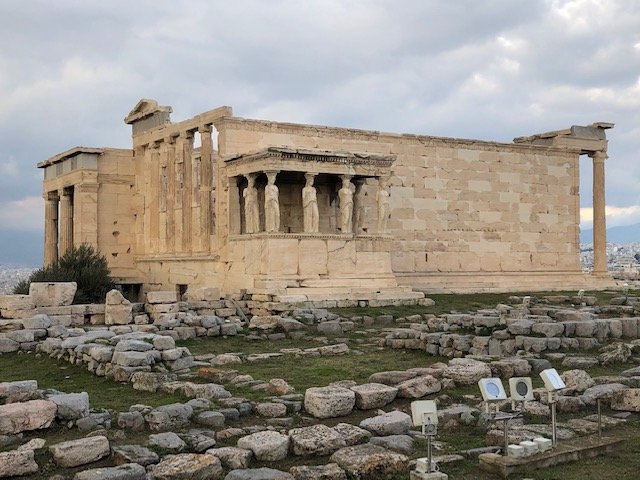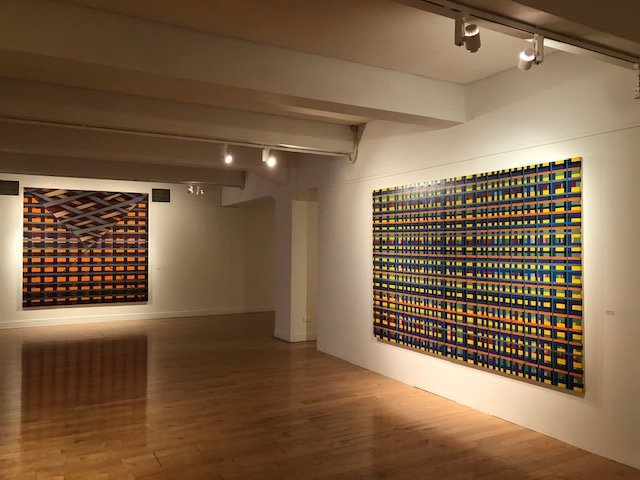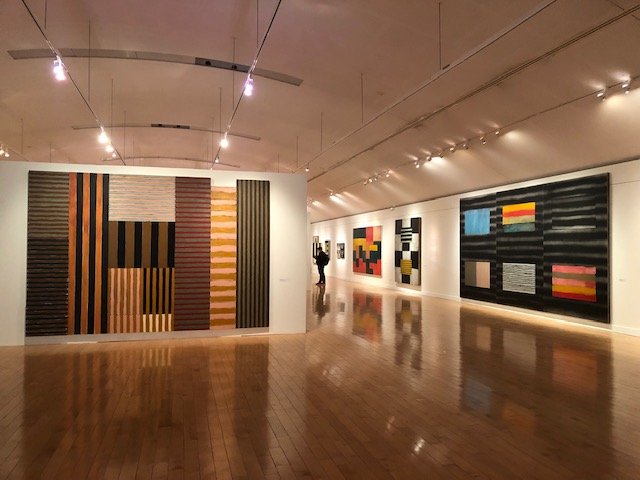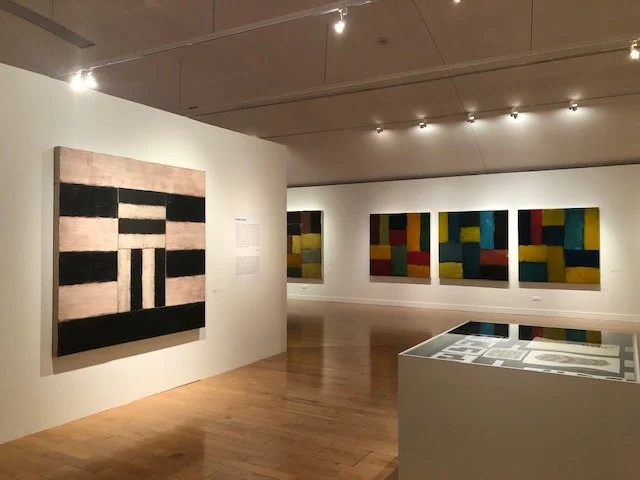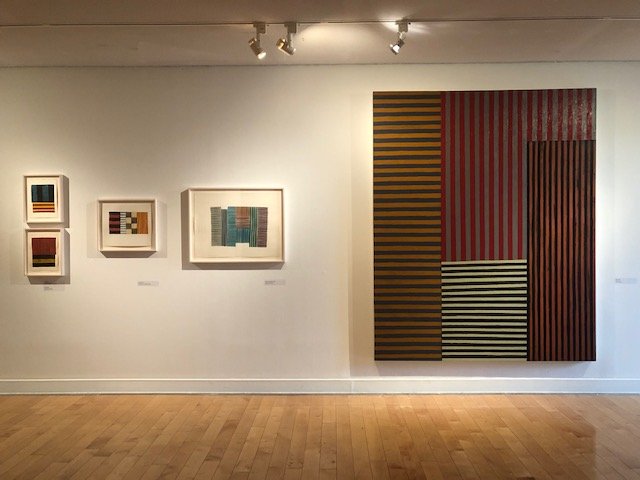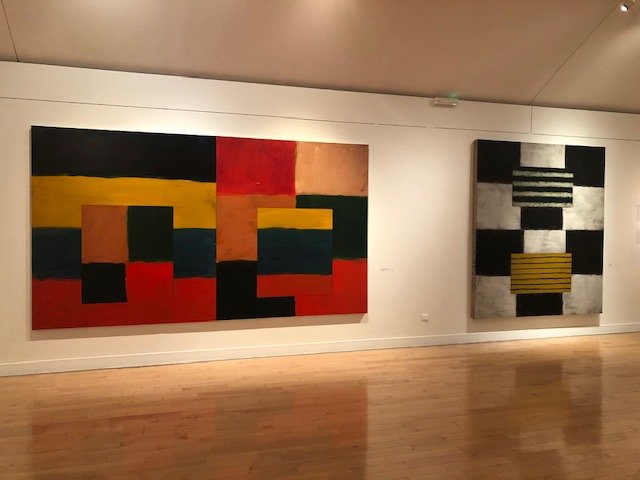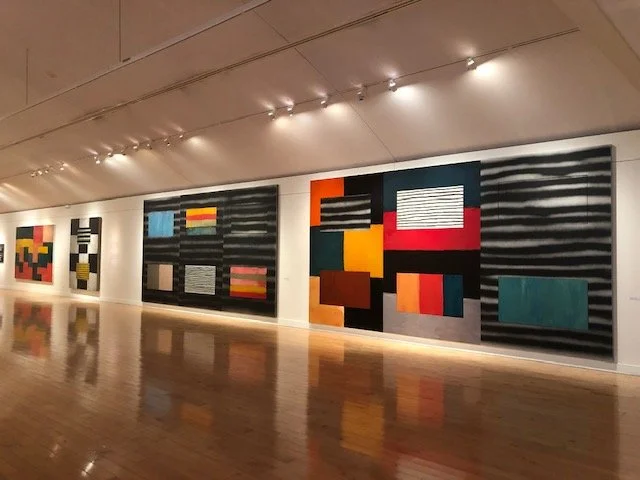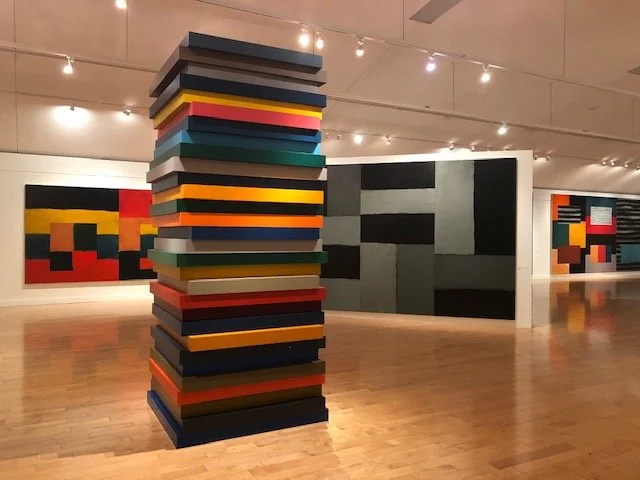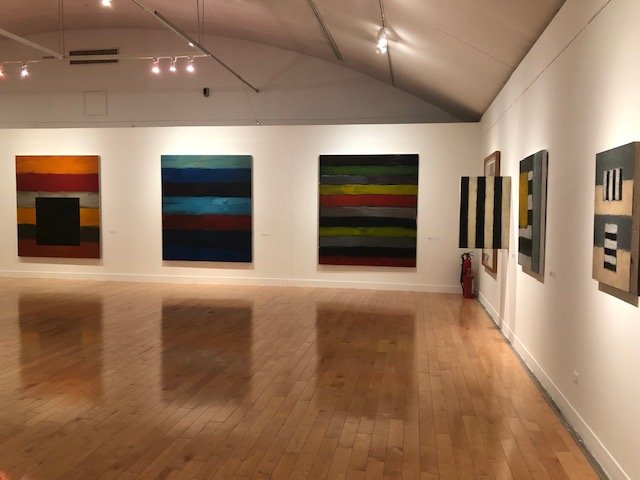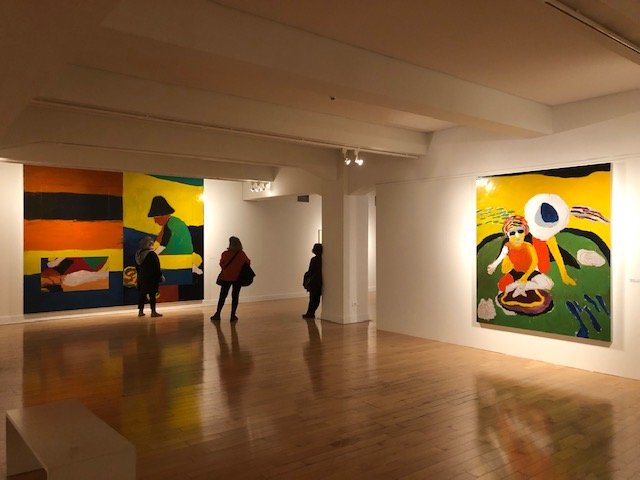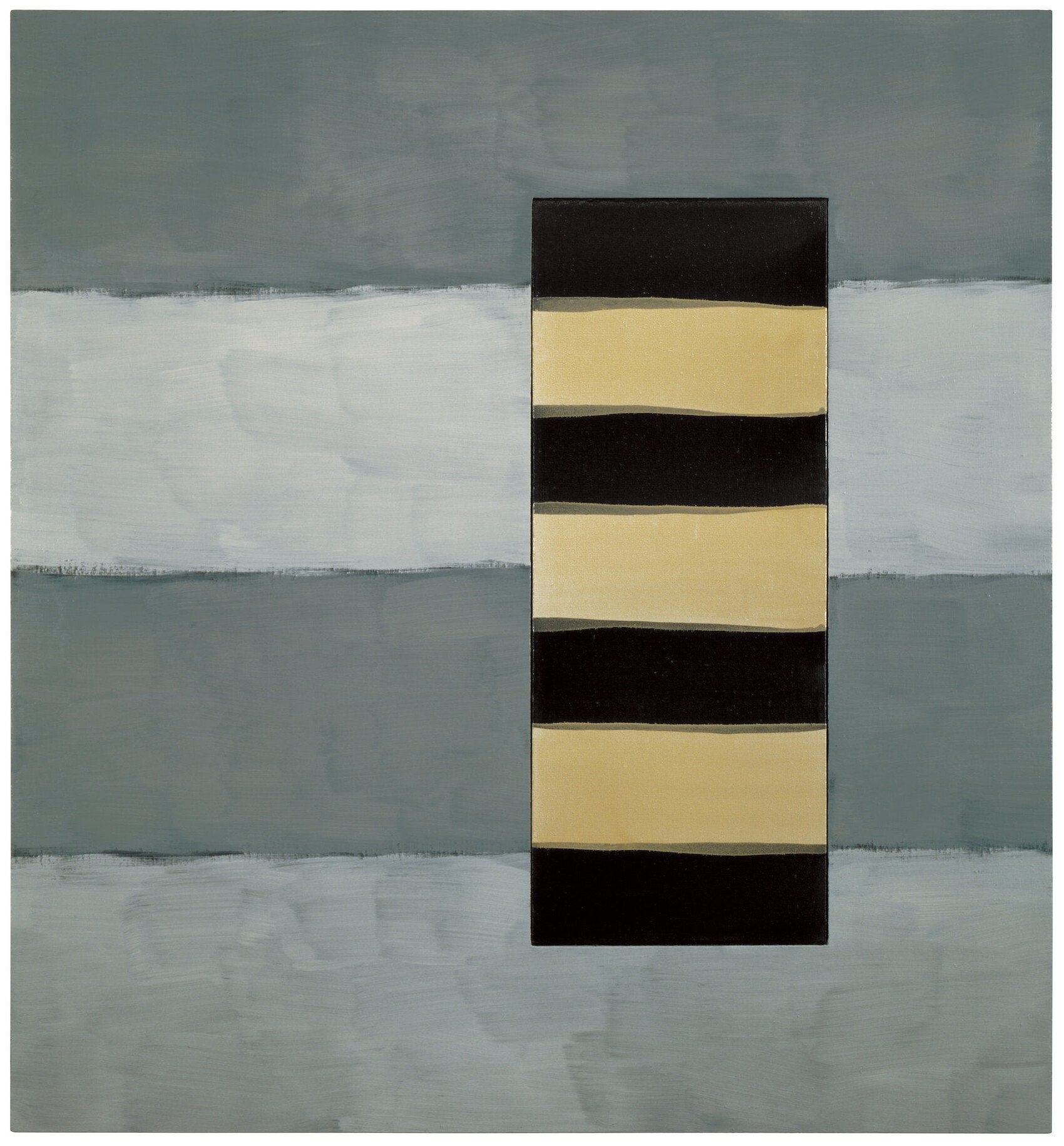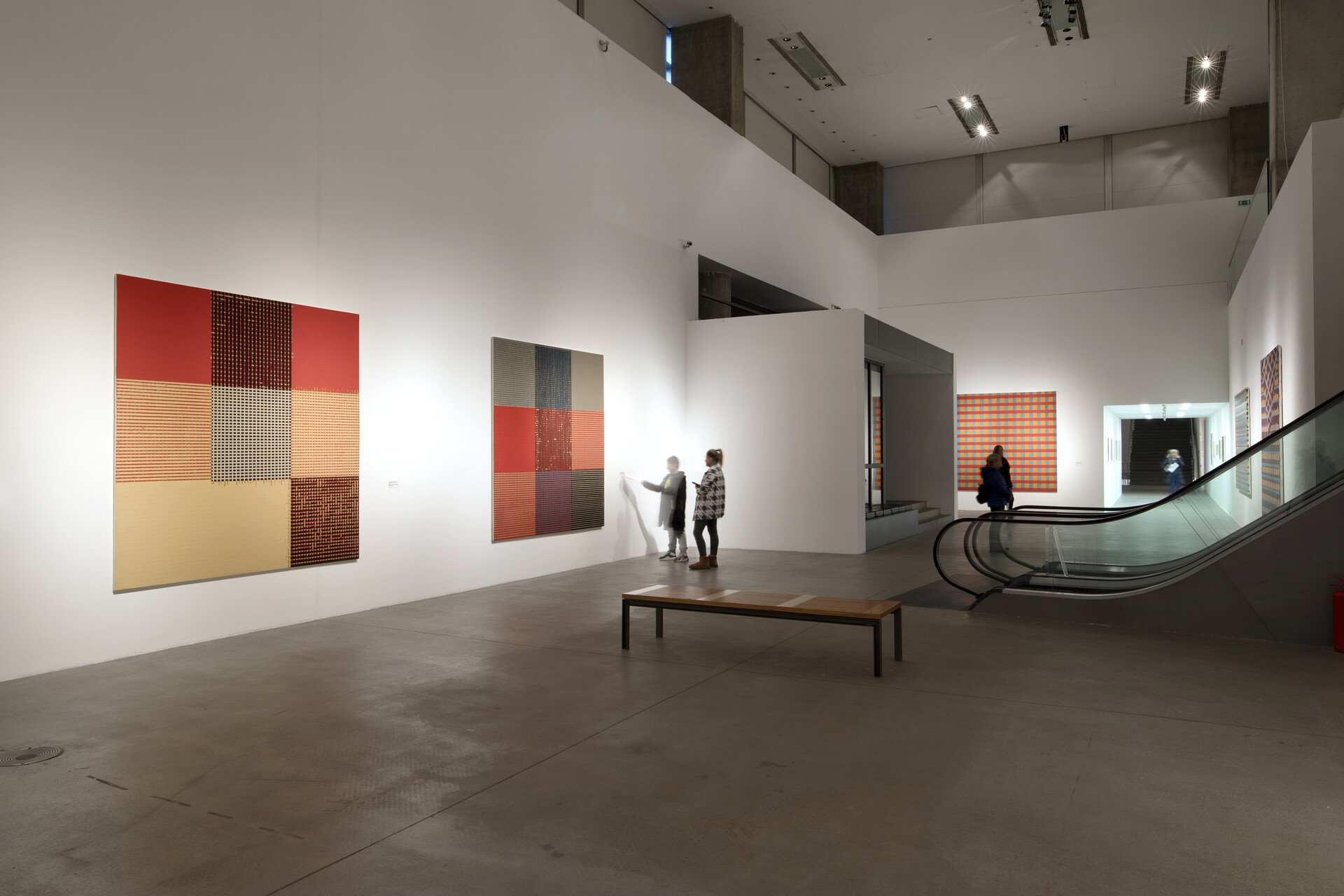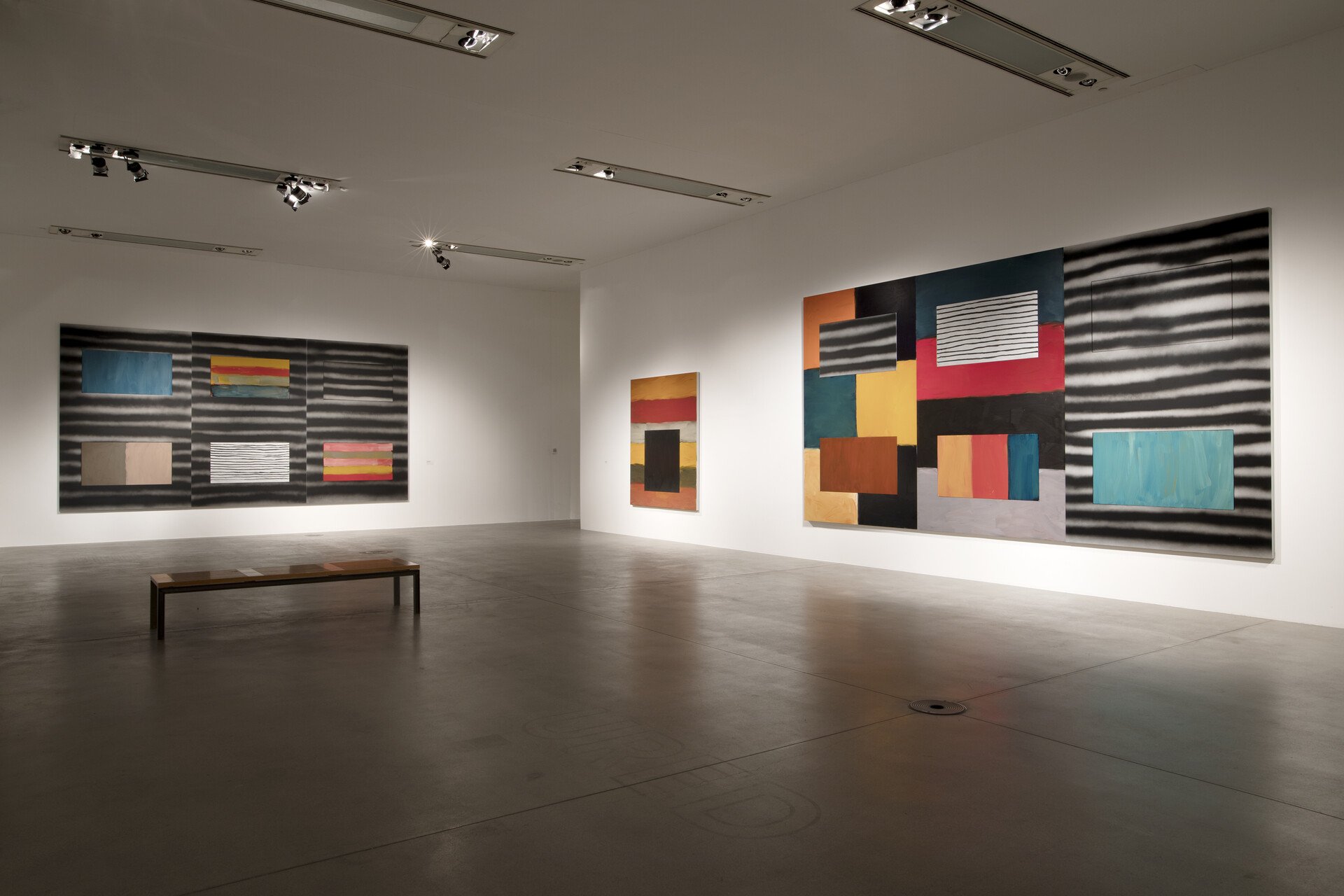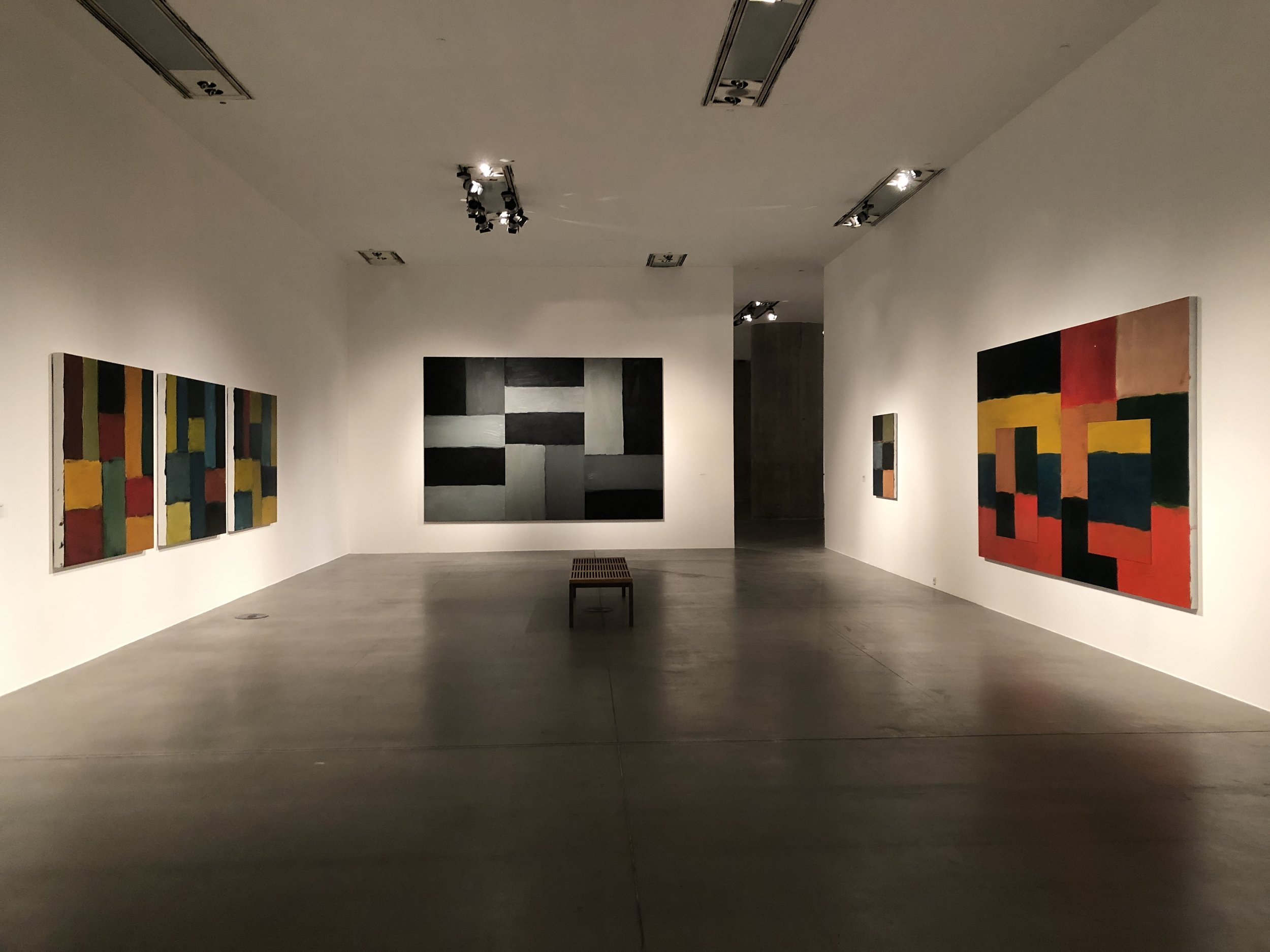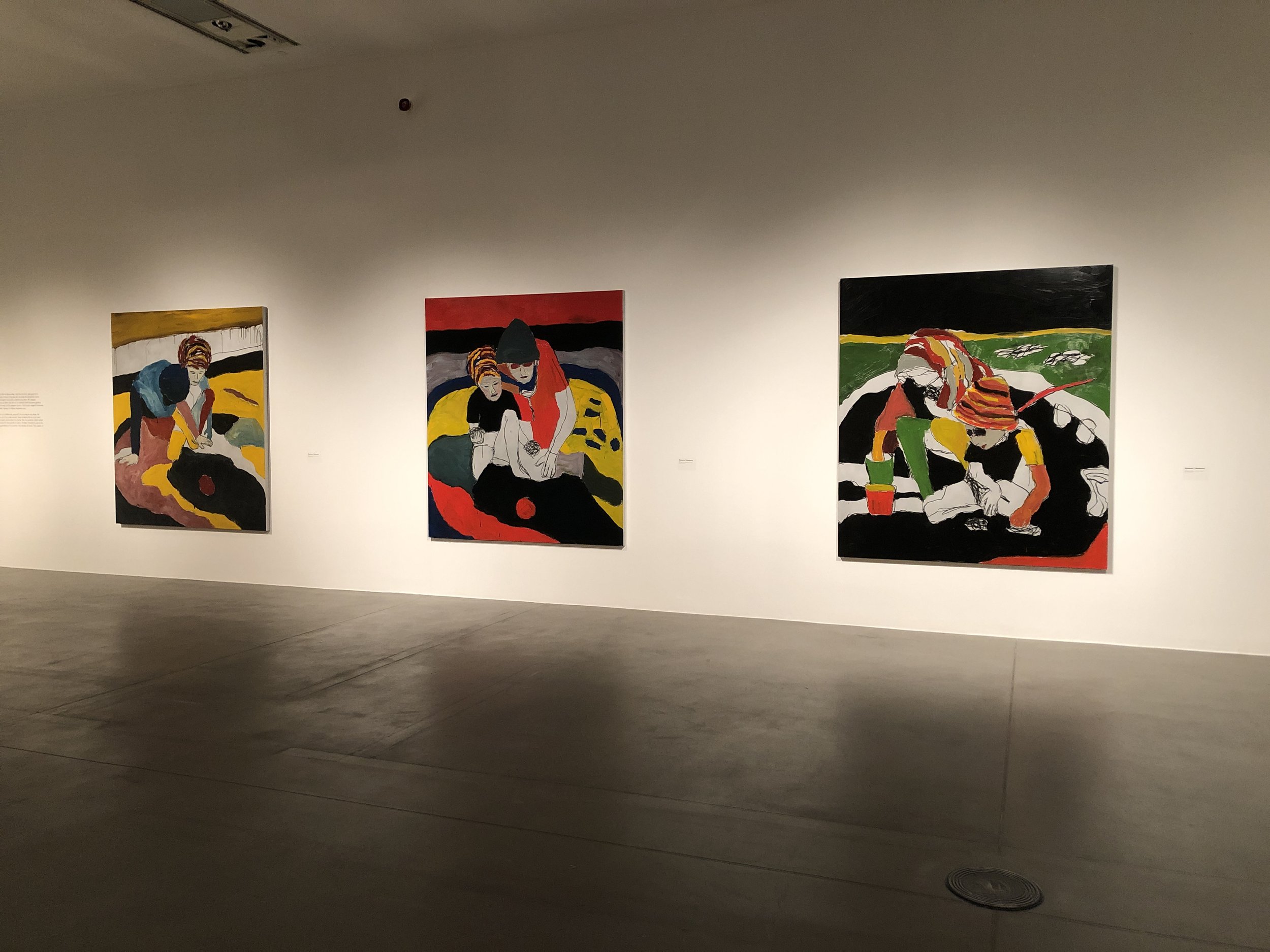Sean Scully: Geometry
as Gesture as Perception
Sean Scully: Passenger—A Retrospective
Museum of Fine Arts
Hungarian National Gallery
Hungary, Budapest
October 14, 2020 through
May 2, 2021
Exhibition Review | February 2020 | Raphy Sarkissian
Sean Scully, installation view of the gallery titled Supergrids. Courtesy of the artist and the Museum of Fine Arts—Hungarian National Gallery, Budapest, Hungary. Photo by Vince Soltész.
Scully’s historical importance lies in the way he has brought the great achievement of Abstract Expressionist painting into the contemporary moment.[1] —Arthur C. Danto
A momentous exhibition staged at the Museum of Fine Arts—Hungarian National Gallery in Budapest, Sean Scully: Passenger—A Retrospective celebrates an illustrious oeuvre that took its course in the mid-sixties. Thoughtfully curated by Dávid Fehér, this chronologically orchestrated survey reveals an expansive legacy of abstract and figurative paintings, works on paper and sculpture, spanning across Sean Scully’s career.
Encountering the corpus of one of the most renowned artists of our time, the viewer is often confronted with the paradoxical simultaneity of geometry and gesture, two primary devices through which Scully’s paintings resourcefully celebrate the medium’s crucial materiality while recurrently eliciting incandescent mirages that virtually transcend the tangibility of impenetrable, material surfaces. A synopsis of Scully’s groundbreaking strategies of artmaking, the retrospective engrosses the viewer in the primordiality of visual, material and perceptual realities.
“One hand is in the ground. And the other is pointing at the sky,” Scully wrote in February 2002 in Barcelona, succinctly referring to abstract painting’s concrete reality (the ground) and lyrical capacity (the sky). Upon facing a painting by Scully, a sense of inaudible music and ineffable choreography permeates the viewer’s sensorial realm. As the visual experience of the perceiver is conditioned by the vantage point and distance from the painting, the tactility of the ground and opticality of the sky become sequentially manifested to the human visual apparatus, shifting perception continually.
Sean Scully, installation view of the gallery titled Uninsideout. Courtesy of the artist and the Museum of Fine Arts—Hungarian National Gallery, Budapest, Hungary. Photo by Vince Soltész.
Presented within two galleries that partly sum up Scully’s recent output, the exhibition culminates in a set of notable works. Ascending and cubic, 30 Also (2018) is a Postminimalist sculpture, majestic in scale and lavish in its polychromatic scheme. An innovative, abstract triptych with six insets, Uninsideout (2018-2020) liberally displays spray paint as shimmering, horizontal ribbons. Figure Abstract and Vice Versa (2019), a painting from an extensive cycle titled Madonna, masterfully encapsulates the artist’s wide-ranging painterly vocabulary by pairing his seemingly abstract practice and recently revived motif of the human figure, now depicting his son Oisín as an archetype of a child playing on the seashore—on his own or in the company of a family member or friend.
In Figure Abstract and Vice Versa, the presence of four instances of the inset, one of Scully’s signature devices, comes across with numerous implications. While the painting pairs figuration and abstraction as an overall diptych, the four insets reveal their apparent roles as formalist means of bridging the gap between Abstract Expressionism and Minimalism: the former realized through painterly bravura and energetic gesturalism, while the latter built around the idea of objecthood, manifested through physically distinct geometric panels incorporated within the whole. Through its pictorial structure and title, this painting also addresses visual perception by means of Gestalt theory in a pioneering manner—both within the career of the artist and across the horizon of the history of painting. Here resemblance and abstraction are inventively reciprocated, as are figure and ground, recalling Maurice Merleau-Ponty’s discussion of the complexity of visuality in relation to Gestalt psychology when he points out to the “forces of distortion, contraction and expansion” that take place within the visual experience.[2]
Installation view of the gallery titled Figure Abstract and Vice Versa at Sean Scully: Passenger—A Retrospective. Courtesy of the artist and the Museum of Fine Arts—Hungarian National Gallery, Budapest, Hungary. Photograph by Vince Soltész.
Indeed, the abstract and pictorial forms in Figure Abstract and Vice Versa distort, contract and expand the semantic values of the terms “figuration” and “abstraction.” Here Scully’s painting, partly derived from photographic images, brings to mind Erwin Panofsky’s influential theoretical essay “Perspective as ‘Symbolic Form,’” in which the author’s “thesis is that painters’ perspective, or the projection of three-dimensional reality on to a plane surface, is never true to reality. Every perspectival method distorts reality in one way or another. The question facing the historian, then, is not whether a given artist or artistic culture can paint in perspective, but which sort of perspective they use.”[3]
As Figure Abstract and Vice Versa assembles abstraction and figuration through photography, it points out to the possibilities of allusion within anti-figurative painting and conversely a sense of flatness within figurative representation, with photography as an intermediary medium through which Scully has been portraying the human figure lately. His son Oisín, his wife Liliane Tomasko, himself and family friends have thus been rendered as pictorial entities that are translations of photographic imagery to possibilities of phenomenological pictures interwoven into the fabric of art history. “Like the thing, the picture has to be seen and not defined, nevertheless, though it is a small world which reveals itself within the larger one, it cannot lay claim to the same substantiality. We feel that it is put together by design, that in it significance precedes existence and clothes itself in only the minimum of matter necessary for its communication,” writes Merleau-Ponty, referring to the paintings of Paul Cézanne.[4] Figure Abstract Vice Versa expressively encapsulates the possibilities of mapping relations among a multiplicity of visual and art-historical realms. A sign of our time, this painting of Scully interrogates visuality, suspending the boundaries between abstraction and resemblance.
Installation view of the gallery titled Architecture of Light that includes Barcelona Dark Wall, chromogenic print mounted on Alu-Dibond behind Plexiglass, 28 by 42 inches. At Sean Scully: Passenger—A Retrospective. Courtesy of the artist and the Museum of Fine Arts—Hungarian National Gallery, Budapest, Hungary. Photograph by Vince Soltész.
Photography on its own also enters Scully’s métier, as exemplified within the exhibition through Barcelona Dark Wall (1997), a rather romanticist if not uncanny chromogenic print depicting a dilapidated architectural setting, wherein a window-opening noticeably echoes the iconic motif of the rectangular form that recurs systematically throughout the abstract, yet not-so-abstract, paintings of the artist.
Though the seemingly abrupt inclusion of Barcelona Dark Wall within an exhibition of primarily modernist painting and drawing may initially bewilder the viewer, the photograph here simultaneously sets itself apart from painting as a medium and connects itself to the cultural matrix within which the emergence of abstract painting can become partially understood as a means of producing what the camera could not or was not intended to achieve. The conceptual parallels between the multiplicity of the photographic print and seriality within the abstract grid (along with modernist painting’s departure from beaux-arts techniques and eventual abandonment of semblance and mimicry) have paradoxically expanded and enriched the arena of visual artmaking. Indeed, the exhibition unveils Scully’s method of connecting abstract painting and a reinvented means of figurative representation to such epistemic disciplines as semiology (with its dialectical, oppositive logic of signification) and phenomenology (with its open-ended inquiry of mind and body).
Installation view of the gallery titled Hidden Narratives at Sean Scully: Passenger—A Retrospective. Courtesy of the artist and the Museum of Fine Arts—Hungarian National Gallery, Budapest, Hungary. Photograph by Vince Soltész.
As Barcelona Dark Wall highlights the window as an inset within the wall, it echoes the organization of forms within many of Scully’s composite paintings that are in essence modernist relief sculptures. Among such polyptychs, two seminal ones are showcased in the gallery that is fittingly named Hidden Narratives. Titled Adoration (1982) and The Bather (1983), these paintings reveal recesses and partial openings that call into mind the architectonic elements in Scully’s photographs. In this sense, despite its self-contained autonomy, Scully’s abstraction comes across as metaphorical of instances of the corporeal and cerebral, manifested through formalist evocations and titles, as eruditely discussed by Kelly Grovier in the essay “‘Breathing Mirrors’: Sean Scully and the Art of Metaphor” of the exhibition catalogue.[5]
Installation view of the gallery titled Sensual Constructions at Sean Scully: Passenger—A Retrospective. Courtesy of the artist and the Museum of Fine Arts—Hungarian National Gallery, Budapest, Hungary. Photograph by Vince Soltész.
Likewise, David Carrier’s illuminating essay, “Putting Abstraction in Touch with Reality: The Achievement of Sean Scully,” attaches the breadth of Scully’s output to “reality” by concluding, “What motivated development from the late 1970s grids to the 1980s panels, on to the later walls of light, landlines, and figurative works, has always been his immediate personal visual experience.”[6] From the outset of the eighties Scully’s consistent projection of the pictorial plane into real space would adamantly interrogate and interrupt the convention of modernist painting as a purely two-dimensional perceptual field. Upon the surface of Scully’s unprecedented multi-panel paintings, such as Rock Me (1986) and Red Mask (1990), the projecting and retracting planes reformulate the self-contained autonomy of modernist abstraction, integrating a newly defined tactility with the opticality of real shadow.
Stela of the Steward Mentuwoser, circa 1944 B.C. (Middle Kingdom, Dynasty 12, reign of Senwosret I, year 17). From Egypt, probably from Northern Upper Egypt, Abydos. Limestone, paint, 40 9/16 by 19 7/8 by 3 1/4 inches. Gift of Edward S. Harkness, 1912. Courtesy of the Metropolitan Museum of Art, New York.
Grave Stele of a Little Girl, circa 450–440 B.C. (Greek, Classical). Parian marble, 31 3/4 by 14 9/16 by 15 1/2 inches. Fletcher Fund, 1927. Courtesy of the Metropolitan Museum of Art, New York.
With the simultaneity of flatness and introduction of real shadow onto the surfaces of Scully’s paintings in the early eighties, we are reminded of Aloïs Riegl’s formalist examination of ancient Egyptian, Greek and Late Roman reliefs. As encapsulated in the foreword of his pioneering book Historical Grammar of the Visual Arts, “Riegl follows a progression from the near view and tactile, static, volumetric, and symmetrical forms in Egyptian art, through the normal view and delicate balance of idealism and naturalism in classical Greek art, to the far view and optical, subjectively perceived, dynamic, and transient form in Hellenistic and Roman art. This progression does not end with Antiquity, but proceeds with various modulations through the Middle Ages, Renaissance, and Baroque period up to our own day.”[7]
Sarcophagus with the Triumph of Dionysos and the Seasons, circa A.D. 260-270 (Roman, Late Imperial, Gallienic). Marble, 34 by 85 by 36 1/4 inches. Joseph Pulitzer Bequest, 1955. Courtesy of the Metropolitan Museum of Art, New York.
In Rock Me, the protrusion of the central panel, articulated through a pair of vertical bands in blue and yellow, gives way to shadows cast on the side panels. Despite the flatness and tactility of the individual canvases, this “relief painting” manifests opticality through shadow, intriguingly recalling a set of diverse antecedents. Scully’s work evokes, for instance, the shallow depth and shadows in Frank Stella’s highly linear and geometricized relief Bechhofen (1972) of the San Francisco Museum of Modern Art. Louise Nevelson’s assemblage Black Wall (1959) of the Tate can be read as another precedent of Rock Me due to its simultaneity of tactility and opticality. Ranging from significantly deep to shallow to flatly surfaced compartments, Black Wall systematically brings together the diverse sensibilities of Late Roman, Classical Greek and Egyptian reliefs. Having assembled entirely shallow, invisibly deep and spatially balanced types of box-like components, the surfaces of Nevelson’s monochromatic sculpture implicitly incorporate the formalist properties of three reliefs at the Metropolitan Museum of Art. First, the spatially deep containers that articulate fluctuations of light and shadow conjure up the highly optical and subjectively perceived Late Roman high relief Triumph of Dionysos and the Seasons (circa A.D. 260-270). Second, the entirely opaque, impermeable and shadowless units point toward the tactile and objectively perceived low-relief Stele of the Steward Mentuwoser (circa 1944 B.C.). And third, the mid-reliefs of Black Wall recall the perfectly balanced Classical Greek relief Grave Stele of a Little Girl (circa 450-440 B.C.). Through its own integration of tactility and opticality, Rock Me of Scully remains in perpetually dynamic dialogue with such ancient and modern reliefs.
Louise Nevelson, Dark Wall, 1959. Painted wood, 104 by 85 by 25 1/2 inches. Courtesy of the Tate, London.
Frank Stella, Bechhofen, 1972. Wood and ramin, 97 by 103 by 8 inches. Gift of Mr. and Mrs. Hamilton Robinson, Jr. Courtesy of the artist and the San Francisco Museum of Modern Art, San Francisco.
Sean Scully, Rock Me, 1986. Oil on canvas, 96 by 126 inches. Courtesy of the artist and Hilti Art Foundation, Schaan, Liechtenstein.
Installation view of the gallery titled Sensual Constructions at Sean Scully: Passenger—A Retrospective. Courtesy of the artist and the Museum of Fine Arts—Hungarian National Gallery, Budapest, Hungary. Photograph by Vince Soltész.
Within the gallery titled Sensual Constructions: Works from the 1980s and 1990s, the physical insets of Scully that predominate his practice disrupt the otherwise orthodox surfaces of numerous paintings. Such compelling works on view as Empty Heart (1987) and Hammering (1990) employ the inset as a means of asserting the objecthood of the geometricized pictorial field that is nonetheless articulated through impastoed layers and gestural exuberance. At once restrained and elegiac, these paintings of Scully reformulate the preestablished limits of Minimalism, often contravening the standardization of forms and imploding the sterility of uniform surfaces through everchanging chromatic possibilities of the gestural brushwork.
Installation view of the gallery titled In Dialogue #2 at Sean Scully: Passenger—A Retrospective. Courtesy of the artist and the Museum of Fine Arts—Hungarian National Gallery, Budapest, Hungary. Photograph by Vince Soltész.
Two galleries titled In Dialogue #1: Soft Edges (Scully and Bonnard) and In Dialogue #2: Fields of Color (Scully and Van Gogh) are particularly rewarding, though not so much for their intention to demonstrate the specific influences of the two artists on Scully so as to package his art in a canonical history. Rather, with a single painting by Pierre Bonnard, Grandmother and a Child (1894), the visitor is confronted with the fundamental questions of what painting can be: a sign of its time, a contest between linearity and coloration, manifestations of possibilities that attach, detach and reattach reality and perception. In such outstanding paintings as Vincent (2002), Princess (2003), Small Barcelona Red Wall (2004), Arles Abend Vincent (2013) and Arles-Nacht-Vincent (2015), rectangular forms are interlocked, evoking warped blocks of brick that are visual sonatas of curvature and layers of seemingly spontaneous patchwork in vivid colorations. The dialogue of Scully with Bonnard, as well as that with Vincent van Gogh, therefore consists of color’s contest with line, culminating in gesture’s contest with geometry. Such contests shed light on the primordiality of perception that culture seems to have set aside through the ideality of imperious geometric forms.
Installation view of the gallery titled Architecture of Light at Sean Scully: Passenger—A Retrospective. Courtesy of the artist and the Museum of Fine Arts—Hungarian National Gallery, Budapest, Hungary. Photograph by Vince Soltész.
Architecture of Light: Walls and Landlines is yet another evocative section of the exhibition, where two formally distinct suites poetically activate dialogues between architecture, nature and the in-betweens. In Landline Sea (2014), diaphanous coats of paint subtly invoke silken bursts of light, while asserting the sheer materiality of the medium of oil. It is a striking painting that measures about seven by six feet high. With a scale that is decidedly commensurate with the viewer’s physicality, the painting eloquently unveils the gestural processes through its six capricious, unevenly spaced horizontal strata. The surface here conveys brisk applications of paint, signaling movement, momentum, a sense of painterly mass and velocity conditioned by pigment, brush, hand and the corporeality of the artist in the process of mark-making. Though there is an underlying geometric pattern that structures the overall composition of the painting, traces of irregular, expressive brushstrokes that have defined the chromatic gradations of the sumptuous surface culminate as suggestions of land, sky and bodies of water, as indicated partly by the work’s title. Geometric and unsystematic forms have been inventively interlaced so as to modulate the orderly composition of the painting through expressive definitions of volume and spatial depth, thereby imbuing abstraction with a reformulation of the landscape genre. Here the landscape is no longer conditioned by a given vantage point, but rather a multiplicity of viewpoints. Landline Sea can be interpreted as a representation of the sea and sky from the standpoint of the individual wandering on the beach, as much as it suggests aerial views of land and bodies of water. Multiple beaches, shores, seas, skies and standpoints: such is the plurality of imagery and perspectival positions evoked through the quasi-geometric composition of chromatic bands, where lines and colors fluctuate through the artist’s extraordinary dexterity.
While the whisks of paint floating upon the surface of Landline Sea reveal the haptic materiality of the medium and the artist’s application of paint through haphazard brushstrokes, the observer is nonetheless taken aback by the pigment’s capacity to transubstantiate the flat surface into pulsing undulations of form and moments of effulgence that appear by means of seemingly random and overlapping hues. And though the six horizontal bands here primarily declare the substantiality of colors, multitudinous shades of grey, blue, cream and brown tucked within each other charge the painting with sparks of radiance.
Enigmatic with their coloration and mesmeric with their instances of subdued and vivid luminosity, Landline Field (2014), Oisín Sea Green (2016) and Landline Oisín Green (2016) openly reveal the artist’s experimental interaction with the planar surface, where layered painterly marks operate as signs of the realms of the body, the lived space, pure space, optical space and painterly space. Despite the fact that the medium of oil inexorably asserts its material presence upon Scully’s surfaces, there remain mirages of volume, mass, weight, space and luminosity that insist to appear and disappear within the viewer’s realm of perception.
Scully’s lifelong undertaking to soften the division between abstraction and figuration permeates throughout this arresting retrospective, where the phenomenology of perception is shaped through geometry and gesture.
Although the landscape before my eyes may well herald the features of the one which is hidden behind the hill, it does so only subject to a certain degree of indeterminacy: here there are meadows, over there perhaps woods, and, in any case, beyond the near horizon, I know only that there will be land and sea, beyond that either open sea or frozen sea, beyond that again either earth or sky and, as far as the limits of the earth’s atmosphere are concerned, I know only that there is, in the most general terms, something to be perceived, and of those remote regions I possess only the style, in the abstract.[8]
Articulating the perception of observed and hypothetical landscapes, a perceptual consciousness that is conditioned by the tactility of the ground and opticality of the sky, these words of Merleau-Ponty run parallel to the visual praxis of Scully.
Sean Scully, Oisín Sea Green, 2016. Oil on aluminum, 85 by 75 inches. On view within the gallery titled Architecture of Light at Sean Scully: Passenger—A Retrospective. Courtesy of the artist and the Museum of Fine Arts—Hungarian National Gallery, Budapest, Hungary.
Notes
Arthur C. Danto, “Sean Scully,” in Unnatural Wonders: Essays from the Gap Between Art and Life (New York: Columbia University Press, 2007), pp. 77-84.
Maurice Merleau-Ponty, Phenomenology of Perception (1962), trans. Colin Smith (New York and London: Routledge, 1995), pp. 48-49.
Christopher S. Wood, A History of Art History (Princeton and Oxford: Princeton University Press, 2019), p. 323.
Merleau-Ponty, p. 323.
Kelly Grovier, “‘Breathing Mirrors’: Sean Scully and the Art of Metaphor,” in Sean Scully: Passenger—A Retrospective, ed. Dávid Fehér (Budapest: Museum of Fine Arts—Hungarian National Gallery, 2020), pp. 61-67.
David Carrier, “Putting Abstraction in Touch with Reality: The Achievement of Sean Scully,” in Sean Scully: Passenger—A Retrospective, ed. Dávid Fehér, pp. 43-59.
Benjamin Binstock, “Aloïs Riegl, Monumental Ruin: Why We Still Need to Read Historical Grammar of the Visual Arts,” in Aloïs Riegl, Historical Grammar of the Visual Arts, trans. Jacqueline E. Jung (New York: Zone Books, 2004), p. 13.
Merleau-Ponty, p. 331.
Sean Scully is currently represented by Lisson Gallery in New York, Kerlin Gallery in Dublin, Kewenig in Berlin and Galerie Thaddaeus Ropac in Paris.
Pireos 138, Benaki Museum, Athens, Greece
Following its presentation at the Museum of Fine Arts in Hungary, Budapest, Sean Scully: Passenger—A Retrospective was exhibited at the Benaki Museum in Athens, Greece, from December 16, 2021 through February 13, 2022.
Video courtesy of Sean Scully and the Benaki Museum, Athens, Greece. Presenters in the order of appearance: George Manginis, Academic Director, the Benaki Museum; Constantinos Papachristou, Curator, the Benaki Museum; Sean Scully, from his studio in New York; Dávid Fehér, Curator of Twentieth-Century and Contemporary Art, the Museum of Fine Arts, Budapest; Director of Central European Research Institute for Art History. Produced by AbFab Productions. © Sean Scully and the Benaki Museum.
Sean Scully: Passenger—A Retrospective. © Sean Scully. Image courtesy of the artist and the Benaki Museum, Athens, Greece.
Curatorial Team
Dávid Fehér, Curator of Twentieth-Century and Contemporary Art, the Museum of Fine Arts, Budapest; Director of Central European Research Institute for Art History
Constantinos Papachristou, Curator, the Benaki Museum, Athens
Pavlos Thanopoulos, Exhibition Designer, the Benaki Museum, Athens
Sean Scully: The Passenger
A Retrospective Exhibition
November 16, 2022—March 12, 2023 at The Museum of Contemporary Art, Zagreb, Croatia
Sean Scully: The Passenger—A Retrospective Exhibition. © Sean Scully. Images courtesy of the artist and the Museum of Contemporary Art, Zagreb, Croatia.













